- Home
- About Us
- Services
- BIM-VDC STANDARDS IMPLEMENTATION
- 3D MODELING
- 3D LASER SCAN-TO-BIM
- 2D CAD TECHNICAL DRAWINGS
- BIM COST ESTIMATION
- 3D MULTIDISCIPLINARY COORDINATION
- BIM ASSET MANAGEMENT, FM, O&M
- 3D & 4D VISUALIZATIONS
- 360° VIRTUAL TOURS
- 3D RENDERING SERVICES
- RECORD PHOTOGRAPHY
- VR & AR PRESENTATIONS
- TRAINING
- RESEARCH & DEVELOPMENT (R&D)
- VIRTUAL CLAIMS
- Products
- Our Experience
- Contact Us

CanBIM Innovation Spotlight Awards
Get-Tech is promoting new technology and innovative solutions that introduce digital tools and processes in AECOO industry. We collaborate with partners around the globe to enable our clients getting easier access to the latest applications and advanced methodologies currently available on the market.
As a CanBIM member, consultant, developer and vendor, we have recently decided to apply for CanBIM Innovation Spotlight Awards, together with our partner, Plannerly



2019 CanBIM Technology Award Commercial Nominees have been announced this week and we have been nominated! To qualify for this award, we had to present how Plannerly contributes to AECOO industry, how it generates time and cost savings and why it is the best candidate to this award.
Let’s review Plannerly and see what qualifies it to the 2019 CanBIM Technology Award.
Plannerly proposes an innovative approach to BIM Management and progress tracking.
Its goal is to simplify BIM, to make the management tools more user-friendly and fun to work with.
Simple drag-and-drop functionality can make any tedious process faster; reusable templates can make new documents in minutes – not hours. The ability to comment and agree on on-line stored BEP content and scope of work has never been easier. Plannerly improves BIM Management practices by making them easy!
Thanks to Plannerly owners have access to an intuitive, collaborative and visual method to identify the BIM they actually need; architect, engineer and consultant can easily agree on exactly what BIM scope they’re signing up for and work to; contractors can manage their BIM requirements in a collaborative and integrated BIM scoping workflow; all together they can easily plan and visually scope BIM projects on a single dedicated and simple platform.
WATCH INTRODUCTION VIDEO
How Does Plannerly Generate Cost Savings?
Plannerly can generate cost savings by creating an opportunity for all project stakeholders to simultaneously agree on BIM plan and scope of work, progress tracking and model quality.
When everything is clear at the beginning, tasks, milestones, LOD levels, information requirements and deliverables are easier to manage and verify. Everyone knows what needs to be done, when and how. There are less chances to make mistakes and/or omissions. There are less chances to under-deliver or create design errors that will result in costly rework and material waste during construction. There are less RFIs and Change Orders that normally result from poor design and not well-defined BIM scope. With Plannerly those problems become not relevant anymore.
Thanks to common platform all stakeholders can easier agree on BIM, develop more collaborative relationships and avoid expensive legal battles through visual BIM planning between owners, architects, engineers, and contractors. Therefore, the cost saving can be “priceless” in many instances.
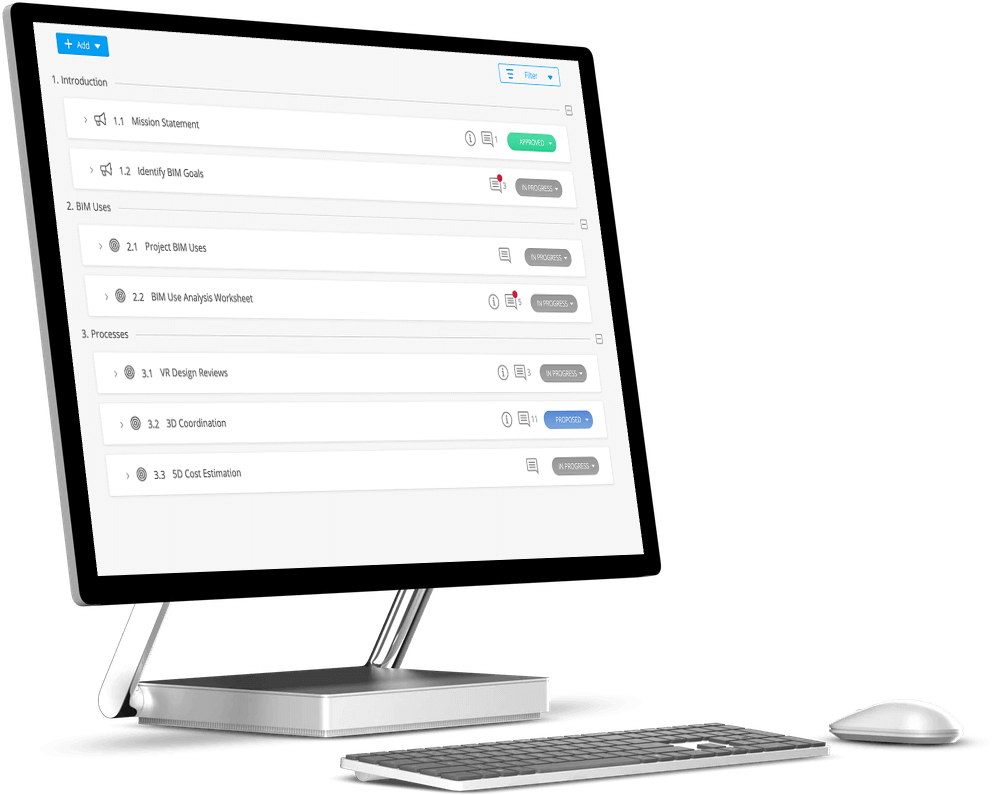
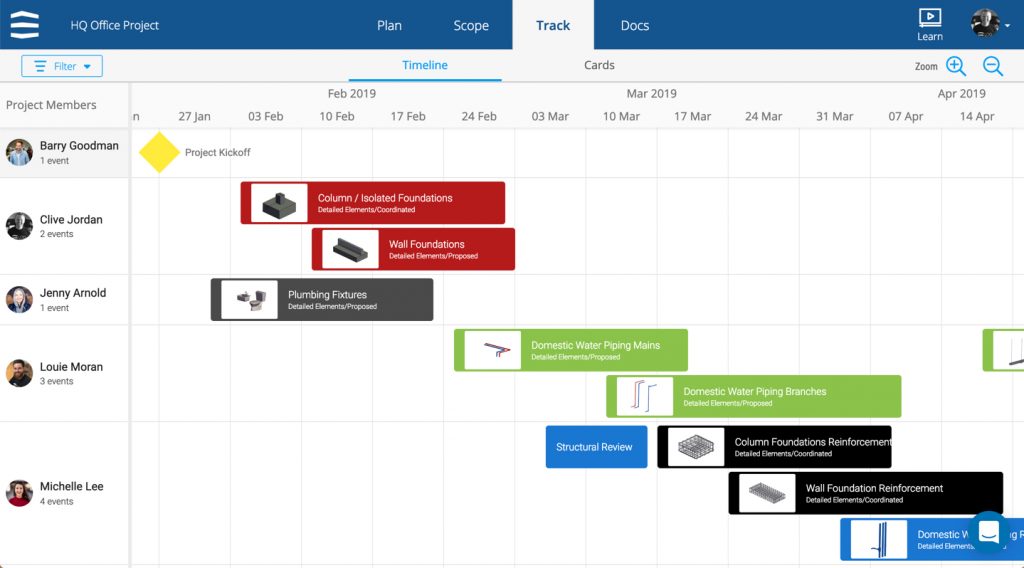
How Does Plannerly Generate Time Savings?
Save Time – that’s one of the main goals of Plannerly. We understand that BIM planning, scoping and contracting can be time consuming – that’s why we’ve optimized every step to get it done in minutes.
Templates included in Plannerly can be used for companies that just start to implement BIM and need examples of BIM Execution Plans and LOD definitions. This significantly reduces the time of searching for the most suitable template document.
Once you create your BEP and invite all project stakeholders, incl. the owner, architect, engineers and contractors, share it with them, to get their comments and collaboratively agree on the final version, that you can publish. BIM Uses can be customized easily on each project through a drag and drop functionality. This means saving time on rewriting everything from scratch. Just filter the database of BIM Uses by a keyword, find the one you need and drag it in the document – a simple solution.
Setting up LOD Matrix? This is the worst of all! But not with the Plannerly. Ready-made templates are there to use as a whole or customized on element by element basis. If you need a new element – just add it, upload a picture, which will be analyzed by a Bot who will remove the background for you – and viola! New item is ready to be included in your project Scope! How simple is that? How much time did this all save?
How Does Plannerly Demonstrate Scalability?
Plannerly has a great Advocate Program that helps to increase industry awareness and engage new users in spreading the news about this innovative solution.
Every day there is more and more users everywhere in the world and more and more Smart Lean BIM™ Partners. GET-TECH Innovative Solutions Inc. is one of them and is proudly promoting Plannerly in Canada! We are already implementing this great tool at the Toronto Pearson Airport, by creating BIM Standards with use of a LOD Planner at GTAA (Greater Toronto Airports Authority) which is managing the largest Canadian airport. We are developing special Scope templates for the aviation industry, by adding tasks for model elements typical for airports, like baggage systems, conveyors, check in counters, security lanes, scanners and metal detectors.
We hope that more Canadian users will join Smart Lean BIM™ movement soon.
We believe in Owners, Architects, Engineers, and Contractors agreeing on BIM.
We believe in simple BIM planning.
We believe in crafting a beautiful and visual BIM management platform.

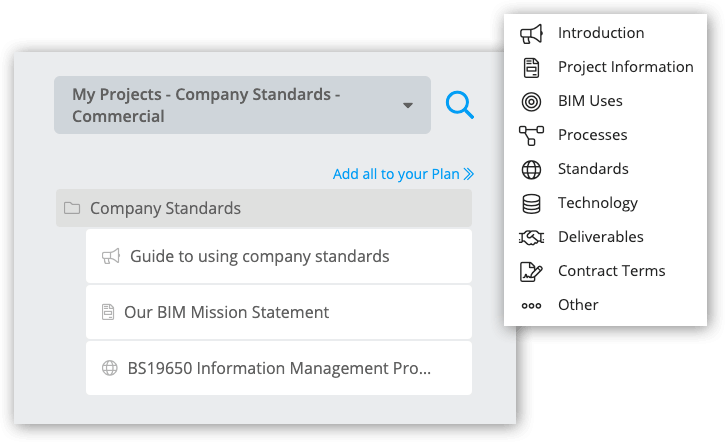
Why is Plannerly Innovative?
Plannerly is one of a kind BIM Management tool. It’s innovative because it provides solutions that were not available to BIM Managers before. If we can visualize physical environment in BIM why not visualize BIM processes, so that they are truly enjoyable and intuitive, almost like a game?
Here is what makes working in Plannerly fun:
Quick project start, adding Project Information, a photo, sketch or rendering, using integrated Google Maps; effortless Team Management – adding teams and invite new members; free Templates to choose from; full browser based editing of BIM planning documents; access anywhere & anytime; embedding videos, surveys, slides, spreadsheets, 3D models and laser scans; selecting preferred LOD Standard out of UK, US or other national standards or defining things yourself; browsing extensive library of BIM objects to quickly define project BIM scopes; using visual and flexible LOD Matrix by quickly turning systems and elements on / off, defining milestones and LOD levels and assigning responsible teams; seamlessly reusing scope packages on future projects; collaborating on the same live BIM planning platform to ensure (by defining the MEA – Model Element Author) that everyone knows who is responsible for what and when; quickly searching the database (including IFC parameters) to define more data requirements; reducing confusion by defining scope and the level of accuracy required for As-Built elements; auto generating BIM Tasks from Scope, assigning them to teams or individual members, defining start and end-date and using integrated timeline to update progress and manage live!! 🙂
How Does Plannerly Improve Connectivity?
Thanks to Plannerlyconnectivity and interoperability become reality. The application was made to meet people on the cloud, in collaborative environment. Those people can use different tools written in the same language, choose to use the same standards and requirements.
Those people can be anywhere in the world but will meet in this one collaborative platform to decide about their common project. Those people usually have different backgrounds and see the BIM projects from different perspective, as owners, architects, engineers and contractors, but they have one thing in common: they have to make it work.
With Plannerly having simplicity in mind, interoperability is simple. Templates allow one to use and assign tasks to every single stakeholder at every project milestone with simple a drag and drop. Printing documents from the cloud in Docs Module to create pdf is another way of making this tool inter-operable with other editing tools. Some project members who prefer more traditional, printed version of BIM Documents can work with the outputs of LOD Planner as well. This way we are covering all project team members’ preferences.
Thanks to possibility of creating Teams and assigning individual members, choosing the right discipline to manage specific tasks is very simple in Scope and Track Module.
Interdisciplinary approach makes Plannerly extraordinary and connecting all different disciplines to break the silos is one of the main reasons this tool exists.

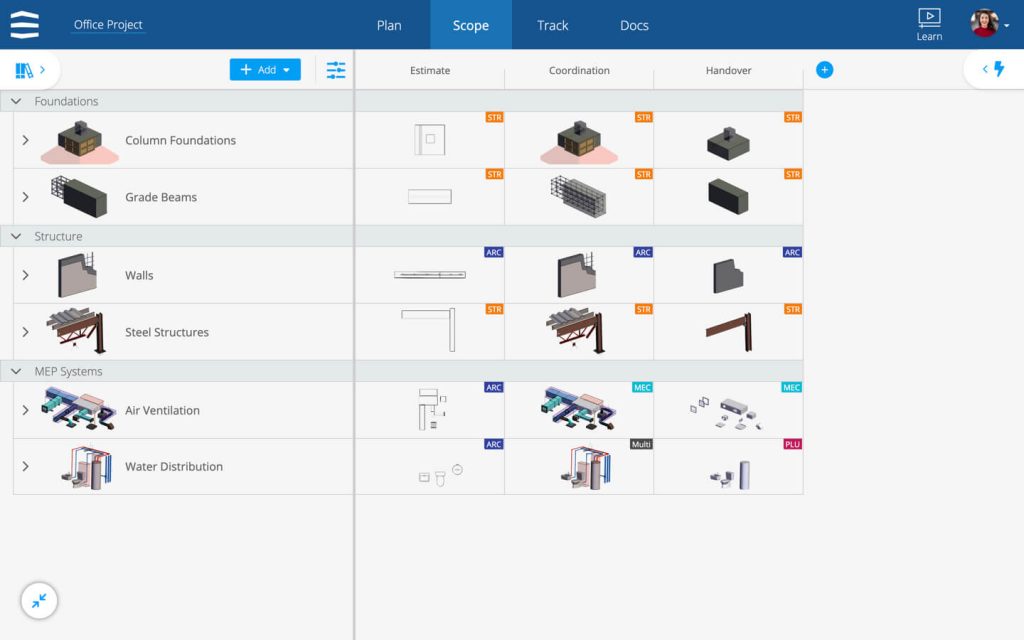
How Does Plannerly Enhance the Project Lifecycle?
The whole project lifecycle can be covered by Plannerly. Plan module helps to set the BEP and standards that help to ensure, that all design, construction and facility operation objectives are met. This technology connects multiple systems within all phases by allowing BIM Managers to easily navigate through those different milestones and assign multidisciplinary tasks in the Scope and Track Module.
This all improves the project work flows dramatically by providing clarity to all project participants.
During the design phase it can help to reduce design errors, provide better quality, coordinated construction documents developed to the desired LOD and Level of Accuracy, as specified and agreed to in BEP. During construction it can help to improve multidisciplinary coordination, reduce RFIs, Change Orders, optimize schedules and reduce waste, all thanks to accurate scoping and progress tracking in the live Plannerly Timeline.
During turn over of the models for Facility Operation Plannerly can help to ensure, that the Owner receives good quality as-builts as defined in the BEP, which can be easily verified by looking at the history of the project contained in the LOD Planner Timeline, indicating if and when each task has been completed. The information stored and archived in LOD Planner after each project can be easily retrieved by the Owners for and made available for future renovations, additions and alternatives.
How Does Plannerly Address Interoperability?
Interoperability in BIM Management has a slightly different meaning than in the BIM Modeling tools, where we mind if the models developed in specific authoring software will work in another software, maintain all the geometry, metadata, classifications and the intelligence acquired in the native software.
In Plannerly, interoperability means, that the teams working on-line, on the same document simultaneously can skip many different file types that would normally be used, like Microsoft Word or PDF, Excel, MS Project, sticky notes to help project team with Lean approach. In LOD Planner instead of all the above formats we can maintain one centralized database of documents on the cloud, access it when needed, simply filter and print to pdf. No more unmanageable one-size-fits-all contracts.
We all know, that in a perfect world BIM Execution Plans would be continuously evolving documents – however they also need to be contractual and archived along the way. Plannerly gives you the best of both worlds – have your cake and eat it: keep your plans Live but also archive your contract versions along the way. Easily collaborate with your team, consultants and clients on the most current BIM Execution Plan in one location.
Finally, we support Open BIM Standards: BIM Professionals using Plannerly now easily implement BIM standards aligned to the US (AIA and BIM Forum), UK (Level 2 / PAS1192 / BS1192 / ISO 19650) or company specific requirements. This is very important aspect in terms of interoperability.

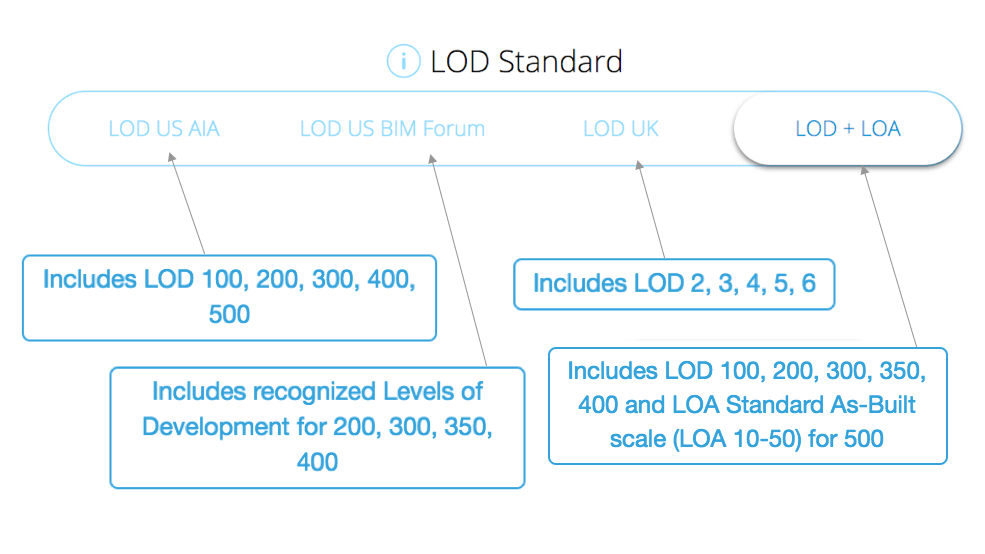
How efficient is this? Again, minutes, not days.

How Efficiently Plannerly Supports Interoperability?
Plannerly is all about efficiency and interoperability, because our application exists to exchange and make use of updated information from a centralized cloud-based location.
It is simple and quick:
Now Architects, Engineers, Contractors and Owners in more than 100 countries use the simple Plannerly framework to quickly create Standards, BIM Execution Plans (BEP / BXP) and project contracts. Start and finish your BIM planning process in minutes, not days.
It is live, collaborative and contractual (at the same time!):
Get the benefit of a collaborative approach (IPD/shared risk/saving) without the need for a collaborative contract.
Collaborate live by inviting internal and external team members or simply print/pdf your project information, processes, BIM contracts, reports and team contact lists.
All printed documents will be archived as BIM contract agreements.
Reusable templates:
Manageable templates allow you to continuously improve your standards for your next project in a simple way. Templates are separated into bite sized sections to selectively update or reuse relevant content from existing projects.
Centrally manage your templates and easily share across your team.
Take advantage of the simple Propose > Publish > Archive workflow.
Viewers comment, editors Propose and managers Publish.
Finally, we can agree on BIM!

Why is Plannerly a Good Example of Interoperability?
Plannerly can unite decentralized teams and integrate people, tools and processes. Each of the three modules offers many good examples of Interoperability:
Plan Module:
BIM Execution Planning was once a disconnected workflow of Word, Excel and PDFs – it was time consuming and, let’s face it, the results were mostly ignored. It was clear, that there is a need for a simple BIM Management Platform, that supports interoperability, a place where all project stakeholders would meet and collaboratively decide on BEP. And not only this, Plannerly provides a few Special Features, like embed videos, surveys, slides, spreadsheets, 3D models and even laser scans that can be shared with project teams for review and approval.
Scope Module:
Previously Level Of Development (LOD) workflows were inflexible and could cause confusion. Disconnected processes (using Excel and pdfs) can also result in miscommunication. Isn’t it time to stop adding unnecessary risk to our BIM projects? With Plannerly connected teams agree on scope together, minimizing risk for everyone.
Track Module:
BIM can be wasteful if it is not planned and managed using Lean design processes. Many projects experience over-modeling, under-modeling, duplicate modeling and lots of rework. With Plannerly one can take control of a project with a Lean BIM management workflow, that all project teams can agree to!
Why Plannerly is the Best Candidate to the 2019 CanBIM Technology Award?
Innovation and Interoperability are the backbones of Plannerly. Why was it developed? Because we want to make things easier and better. Our values describe it best:
Our passion is SmartLeanBIM™ Continuous improvement runs through our veins and we believe that real magic happens at the intersection of BIM and Lean.
Our mission is to enable the optimization of global design management for Owners, Architects, Engineers and Contractors.
Our value is to support a culture of simple BIM Management – one where BIM Execution Plans, Scopes, Contracts, and Management are completed in minutes, not days.

The winners of the CanBIM Innovation Spotlight Awards will be announced on the 25th of September 2019 during an Award Ceremony in Toronto.
We are very excited about the nomination to 2019 CanBIM Technology Award and wish good luck to all the nominees!
Let’s find out who are the winners of this year’s CanBIM Innovation Spotlight Awards during the event, on CanBIM website and social media.
